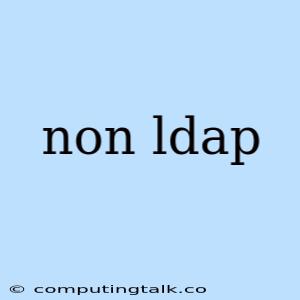The World Beyond LDAP: Exploring Alternatives for User Authentication
LDAP, or Lightweight Directory Access Protocol, has long been the standard for directory services and user authentication. It's a robust system, but it comes with its own set of complexities and limitations. What if you're looking for a solution that's more flexible, efficient, or simply better suited to your specific needs? This is where the concept of non-LDAP comes into play.
Imagine a scenario where you're working with a legacy system or a highly distributed application. Integrating with LDAP might feel like trying to fit a square peg into a round hole. You need something more adaptable, something that can work seamlessly with your existing infrastructure and workflows. That's where the realm of non-LDAP solutions shines.
Why Consider Going Beyond LDAP?
There are several compelling reasons to explore alternatives to traditional LDAP:
- Complexity: LDAP can be intricate to configure and manage, requiring specialized expertise and potentially leading to higher operational costs.
- Scalability: For large-scale systems with a growing user base, LDAP's centralized nature can pose scalability challenges.
- Flexibility: LDAP often struggles to adapt to unique user management needs, particularly for non-standard applications.
Exploring the Landscape of Non-LDAP Solutions
The world of non-LDAP authentication is vast and diverse, offering a spectrum of solutions to meet various requirements. Here's a glimpse into some popular alternatives:
1. Database-based Authentication:
- Leveraging your existing database system for user management can be a straightforward and cost-effective approach.
- Popular choices include relational databases like MySQL, PostgreSQL, or NoSQL solutions like MongoDB.
- This method provides you with the flexibility to tailor your authentication schema to your specific needs.
2. API-based Authentication:
- Modern applications often rely on APIs for communication, making API-based authentication a natural fit.
- Services like Auth0, Okta, and Keycloak provide secure and scalable authentication solutions via their APIs.
- This approach offers high flexibility and ease of integration with various systems.
3. Token-based Authentication:
- Token-based authentication relies on issuing and verifying secure tokens to authenticate users.
- JWT (JSON Web Token) is a widely used standard for implementing token-based authentication.
- This approach is highly secure and can be implemented with minimal server-side state.
4. OpenID Connect (OIDC):
- OIDC builds upon OAuth 2.0, providing a standard for federated identity management.
- It allows users to authenticate with their existing accounts from platforms like Google, Facebook, or Twitter.
- OIDC is ideal for applications that need to streamline user login and integrate with popular social platforms.
Selecting the Right Non-LDAP Solution
Choosing the right non-LDAP solution depends on various factors, including:
- Your specific requirements: Consider your user base, application needs, and security considerations.
- Budget and resources: Factor in the cost of implementation, maintenance, and ongoing support.
- Integration complexity: Evaluate how easily the chosen solution integrates with your existing infrastructure.
Non-LDAP in Action: Real-World Examples
Here are some scenarios where non-LDAP solutions shine:
- Microservices Architecture: In a microservices environment, each service might have its own authentication mechanism. API-based authentication can provide a flexible and scalable approach.
- Legacy Systems: When integrating with older systems that don't support LDAP, database-based authentication or API-based solutions can bridge the gap.
- Social Login: For applications seeking user-friendly login experiences, OIDC provides seamless integration with popular social platforms.
Tips for Success with Non-LDAP
- Thorough Planning: Carefully define your requirements, security needs, and integration points before choosing a solution.
- Security Best Practices: Implement strong security measures, such as encryption, multi-factor authentication, and regular security audits.
- Documentation and Training: Ensure adequate documentation and training for your team to manage and maintain the chosen solution.
Conclusion
While LDAP remains a solid choice for many scenarios, exploring the world of non-LDAP solutions offers a range of possibilities. By carefully considering your specific needs, you can find a solution that aligns perfectly with your application's requirements, ensuring efficient, secure, and adaptable user management. The future of authentication lies in embracing the diverse tools and techniques available beyond traditional LDAP, empowering developers and organizations to achieve their goals with greater flexibility and control.
